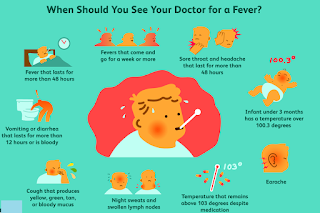A fever is a temporary increase in your body temperature, often due to an illness. It is a common sign of an infection. if body temperature rises above the normal range of 98–100°F (36–37°C), then we can say , the person has a fever.
It temperature stops rising and levels off , people describes it as chills. Fever, also referred to as pyrexia, is defined as having a temperature above the normal range due to an increase in the body's temperature set point.
- Headache
- Warm forehead
- Chills
- Aching muscles
- General feeling of weakness
- Sore eyes
- Loss of appetite
- Dehydration
- Swollen lymph nodes
Infants or young children who have a fever may also experience:
- Greater irritability than usual
- Lethargy
- Flushed skin
- Paleness
- Difficulty swallowing
- Refusal to eat, drink, or breastfeed
How to measure a temperature of your body ?
You can measure your body temperature by different ways like..
To use oral thermometer
Clean the tip using cold water and soap, and then rinse it. After cleaning turn on the device.
Place the tip under the tongue, toward the back of the mouth, and close the mouth. Or, place it under the armpit and hold the device close to the body.
Wait until there is a flash or the thermometer beeps. Read the temperature.
Ear
Ear-based thermometers measure the temperature, this is knows as eardrum. An ear-based thermometer uses a digital readout and delivers results in seconds.
Hold the thermometer up to your ear, with the infrared sensor pointing toward your ear canal, turn it on. Most models will beep when the reading is complete.
Don’t insert an ear thermometer into the ear canal. Because it uses infrared radiation.
Without the help of thermometer
The mostly used method to measure the temperature without the thermometer is touch. When you measure the temperature without thermometer, first you touch your own skin than you touch another person, if the person is hotter than you, he or she may have fever.
Other method is pinching on the back of your hand, if your skin does not snap back quickly, you could be dehydrated. Dehydration may be symptom of the fever.
Causes
Fever or elevated body temperature might be caused by:
- A virus
- A bacterial infection
- Heat exhaustion
Certain inflammatory conditions such as rheumatoid arthritis — inflammation of the lining of your joints (synovium)
A malignant tumor
Some medications, such as antibiotics and drugs used to treat high blood pressure or seizures
Some immunizations, such as the diphtheria, tetanus and acellular pertussis (DTaP) or pneumococcal vaccine.
Types of fever :-
Intermittent fever : The temperature is elevated but falls to normal (37.2°C or below) each day ( e.g. malaria, leishmaniasis, pyemia).
Remittent fever : The temperature falls each day but not to normal. ( e.g. infective endocarditis).
Continuous fever : The temperature remain above the normal and does not fluctuate mor than 1°C in 24 hrs. ( e.g. meningitis, unrinary track infection etc..)
Treatment
When people are ill, their body's immune system fights the disease, and so the body temperature rises. Fever is a defensive measure of the body against the germs: the life cycles of the germs are disrupted when the body temperature rises.
Doctors sometimes recommend medications called antipyretics to lower a person’s temperature.
Examples include non steroidal anti-inflammatory drugs (NSAIDs), such as ibuprofen. Acetaminophen (Tylenol) can also reduce a fever. Aspirin can help, but it is not suitable for children, and it may not be suitable for people who take blood thinners. Paracetamols are also used for the treatment of fever, it reduces the body temperature.
If fever is due to bacterial infection, doctor may prescribe antibiotics but if it is due to viral infection doctor will not prescribe the antibiotics because viruses are not treated by antibiotics.
When to see doctor
If your temperature exceeds 104°F (40°C) or it’s not responding to fever-reducing medication, consider contacting your doctor. A child who has a seizure should see a doctor. The doctor may suggest controlling their temperature with acetaminophen and ensuring that they drink plenty of fluids.
In children high temperature may develop febrile seizure. These often result from an ear infection, gastroenteritis, or a respiratory virus, and they are not usually serious. There are two type of seizure,
1) Simple febrile seizure :- It lasts from few seconds to 15 mins.
2) Complex febrile seizure :- It lasts more than 15 mins, it is more serious than simple febrile seizure.
Tips for treating the fever
- Take fever reducer
- Avoid the heat
- Stay hydrated
- Rest
- Healthy diet
- Boost your immunity
- Wet shock treatment
- Try homeopathy






